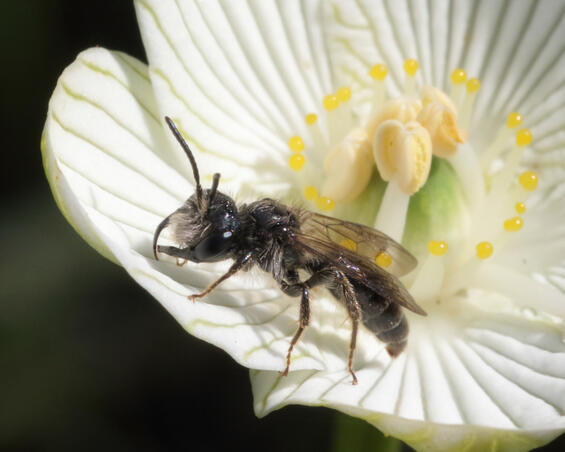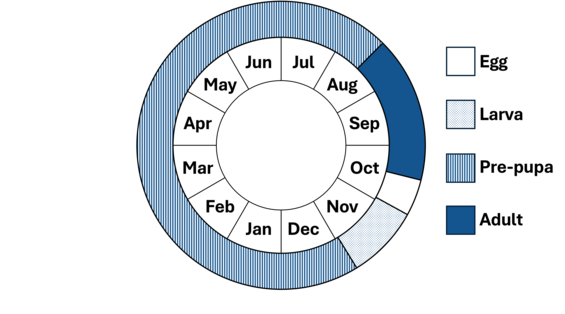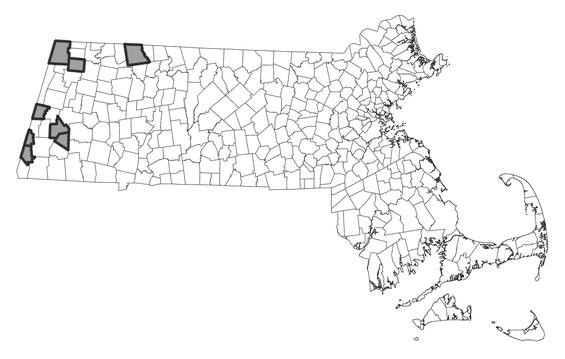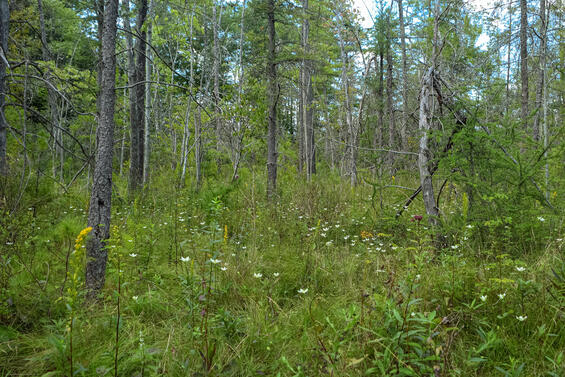- Scientific name: Andrena parnassiae
- Species of Greatest Conservation Need (MA State Wildlife Action Plan)
- Threatened (MA Endangered Species Act)
Description

Parnassia miner (Andrena parnassiae) on fen grass of Parnassus (Parnassia glauca)
The parnassia miner (Andrena parnassiae) is a medium sized bee, 8-10 mm (0.31-0.39 in) in length, similar in appearance to other species of Andrena in Massachusetts. It is notable for the long black setae (hairs) over the top of the thorax and much of the head. The black setae contrast with long white setae on the sides of the thorax and the legs. The abdomen is black with few setae, but each segment has a narrow, often interrupted band of white setae along the posterior margin. Both the male and female have a relatively wide head as compared to other Andrena species. The head of the male is conspicuously wider than the thorax and abdomen, and in lateral view the cheek is almost twice as wide as the eye. The jaws of the male are long and sharp, with tips that extend to the opposite margins of the head (Mitchell 1960).
Life cycle and behavior
The parnassia miner specializes in collecting pollen and nectar from flowers of fen grass of Parnassus (Parnassia glauca). In Massachusetts, fen grass of Parnassus blooms in late summer and early autumn, with adult parnassia miner bees flying from late August to early October.
Female parnassia miner bees are most often found visiting flowers of fen grass of Parnassus. Males sometimes obtain nectar from other flowering plants, but are also typically found on fen grass of Parnassus, either obtaining nectar or waiting for females. It is not unusual for mating to occur on fen grass of Parnassus flowers. Although nests of the parnassia miner have not been documented, it is presumably a solitary ground nester like other Andrena species, with the nest not far from concentrations of host plant. After mating, the female searches for an appropriate nest site and excavates a tunnel in the ground with brood cells located at the tips of lateral branches. Each cell is lined with a waterproof material produced by a gland at the tip of the abdomen. As with other species of Andrena, presumably nests have up to ten brood cells; a single female may construct several nests during the adult lifespan (typically about two weeks, but up to four). Nest tunnels vary in depth, but can be as deep as 30 cm (12 in). The female provisions each brood cell in the nest with a mixture of nectar and pollen. After provisioning, a single egg is laid in each cell before it is sealed. After hatching, the larva feeds on the mixture of nectar and pollen, molting four times as it grows. About a month after hatching, the larva is a fully grown pre-pupa, which remains dormant through the winter. The following spring or early summer, pupation occurs. Adult bees emerge when fen grass of Parnassus is in bloom.

Distribution and abundance
The parnassia miner ranges from Vermont south to North Carolina and Tennessee, and west to Wisconsin (Ascher & Pickering 2020). In Massachusetts, the parnassia miner is only known from Berkshire and Franklin Counties.

Distribution in Massachusetts.
1999-2024
Based on records in the Natural Heritage Database.
Habitat
In Massachusetts, the parnassia miner inhabits calcareous fens and other calcareous wetlands with fen grass of Parnassus (Parnassia glauca).
Healthy habitats are vital for supporting native wildlife and plants. Explore habitats and learn about conservation and restoration in Massachusetts.

Calcareous fen with fen grass of Parnassus (Parnassia glauca) in bloom, habitat for the parnassia miner.
Threats
The parnassia miner is threatened by habitat loss and hydrologic alteration that disrupts its wetland habitats. Other potential threats include invasion by exotic plants, eutrophication or other water pollution, introduced pathogens, aerial insecticide spraying, non-target herbicide application, and off-road vehicles. The parnassia miner is a northern species; in the southern portion of its range, both it and fen grass of Parnassus only occur at higher elevation. Therefore, the parnassia miner is vulnerable to a warming climate. Northward range expansion may be possible, though this has not yet been documented.
Conservation
Land protection and habitat management are the primary conservation needs of the parnassia miner in Massachusetts. In particular, calcareous fens and other calcareous wetlands with fen grass of Parnassus (Parnassia glauca) should be conserved, restored, and managed to maintain habitat for this species and other species dependent on such habitats.
Survey and monitoring
Most calcareous wetlands in Massachusetts have been surveyed for the parnassia miner and it is unlikely that many additional populations will be found. Known populations of this species should be surveyed to document persistence at least once every 25 years; every 10 years is more desirable when practicable.
Management
Management of calcareous fens and other calcareous wetlands benefits a suite of rare and threatened species. Restoration and maintenance of natural hydrology and control of common reed (Phragmites australis), purple loosestrife (Lythrum salicaria), reed canary grass (Phalaris arundinacea), and other invasive exotic plants are of primary importance. Habitat condition should be monitored and management adapted as needed.
Research needs
The natural history and conservation needs of the parnassia miner are not fully understood, and need further study as applicable to this species in Massachusetts. In addition, the future effects of a warming climate on this species are unpredictable and should be documented.
Acknowledgements
Michael F. Veit has contributed significantly to knowledge of the parnassia miner in Massachusetts, and provided much of the information presented here.
References
Ascher, J.S., and J. Pickering. 2020. Discover Life bee species guide and world checklist (Hymenoptera: Apoidea: Anthophila). http://www.discoverlife.org/mp/20q?guide=Apoidea_species.
Mitchell, T.B. 1960. Bees of the Eastern United States. Volume 1. North Carolina Agricultural Experiment Station Technical Bulletin No. 141, Raleigh, North Carolina. 538 pp.
Contact
| Date published: | March 26, 2025 |
|---|